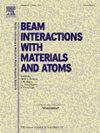Analytical investigation of biological response of different tissues to proton beam radiation using phenomenological and biophysical models
IF 1.4
3区 物理与天体物理
Q3 INSTRUMENTS & INSTRUMENTATION
Nuclear Instruments & Methods in Physics Research Section B-beam Interactions With Materials and Atoms
Pub Date : 2025-03-04
DOI:10.1016/j.nimb.2025.165667
引用次数: 0
Abstract
In particle radiation therapy, the relative biological effectiveness (RBE) is used to evaluate the biological response of human tissues exposed to radiation. The microdosimetric approach may well determine the distribution of RBE-weighted doses of charged particle beams based on dose-mean specific energy with constant innovations and modifications. In this study, the results obtained from the biophysical model (such as the microdosimetric kinetic model (MKM)) with the determined domain size (rd) have been compared to phenomenological models (such as the Wedenberg, Carabe, and McNamara models) which do not consider variable domain size. The α (linear term of the cell survival curve) and D10 (dose value at 10% cell survival fraction) quantities variations as a function of particle linear energy transfer (LET) have been analyzed using different RBE models based on animal cell lines, and human cancer cell lines such as human salivary gland (HSG) and glioma, together with the corresponding experimental data. Besides, the impact of variations in prescribed biological dose on the spread-out Bragg peaks (SOBP) calculated by applying the MKM using various cell lines is indicated. The findings show that the D10 and α parameters estimated applying the -based MKM adapt better to the published experimental datasets than those applying the LET-based phenomenological models. The MKM calculations based on microdosimetric specific energy at the treatment planning system (TPS) can be well used to predict the physical and biological properties of heavy-ion beams.
利用现象学和生物物理模型分析研究不同组织对质子束辐射的生物反应
在粒子放射治疗中,相对生物有效性(RBE)被用来评价人体组织暴露于辐射下的生物反应。微剂量学方法通过不断的创新和改进,可以很好地确定基于剂量平均比能的带电粒子束的rbe加权剂量分布。在这项研究中,从生物物理模型(如微剂量动力学模型(MKM))获得的结果与确定域大小(rd)的现象模型(如Wedenberg, Carabe和McNamara模型)进行了比较,这些模型不考虑可变域大小。采用基于动物细胞系和人唾液腺(HSG)、胶质瘤等肿瘤细胞系的不同RBE模型,分析了α(细胞存活曲线线性项)和D10(10%细胞存活分数下的剂量值)随粒子线性能量传递(LET)的变化规律,并结合相应的实验数据。此外,还指出了规定生物剂量的变化对各种细胞系应用MKM计算出的铺展布拉格峰(SOBP)的影响。结果表明,基于Z1D *的MKM估计的D10和α参数比基于let的现象学模型更能适应已发表的实验数据集。基于处理计划系统(TPS)微剂量比能的MKM计算可以很好地预测重离子束的物理和生物特性。
本文章由计算机程序翻译,如有差异,请以英文原文为准。
求助全文
约1分钟内获得全文
求助全文
来源期刊
CiteScore
2.80
自引率
7.70%
发文量
231
审稿时长
1.9 months
期刊介绍:
Section B of Nuclear Instruments and Methods in Physics Research covers all aspects of the interaction of energetic beams with atoms, molecules and aggregate forms of matter. This includes ion beam analysis and ion beam modification of materials as well as basic data of importance for these studies. Topics of general interest include: atomic collisions in solids, particle channelling, all aspects of collision cascades, the modification of materials by energetic beams, ion implantation, irradiation - induced changes in materials, the physics and chemistry of beam interactions and the analysis of materials by all forms of energetic radiation. Modification by ion, laser and electron beams for the study of electronic materials, metals, ceramics, insulators, polymers and other important and new materials systems are included. Related studies, such as the application of ion beam analysis to biological, archaeological and geological samples as well as applications to solve problems in planetary science are also welcome. Energetic beams of interest include atomic and molecular ions, neutrons, positrons and muons, plasmas directed at surfaces, electron and photon beams, including laser treated surfaces and studies of solids by photon radiation from rotating anodes, synchrotrons, etc. In addition, the interaction between various forms of radiation and radiation-induced deposition processes are relevant.

 求助内容:
求助内容: 应助结果提醒方式:
应助结果提醒方式:


